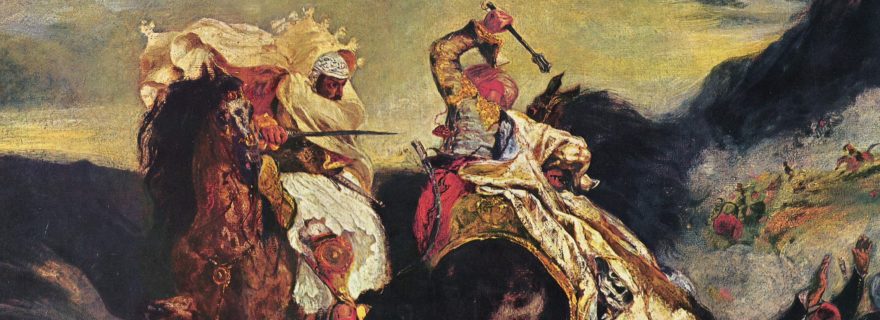Militant Islam between literature and pre-Islamic history
Contemporary militant Islam is prone to using classical Arabic literature to legitimise violence. This raises questions as to how classical Arabic traditions are represented and appropriated by militant Islamists. The idea of pre-Islam is a case in point.
Although it is all over the news, militant Islam is by no means a new phenomenon. Muhammad took arms to defend his fledgling Muslim state in Medina, and Islam’s initial spread across Arabia and into the wider Middle East was accompanied by military campaigns. Over the subsequent 1000 years, Islam spread further and deeper into Asian and African society as populations converted without military coercion, but memories of Muhammad’s military exploits persisted.
Militant groups point to Muhammad and his community’s campaigns as a precedent for legitimising violence, and this makes militant Islam a distinctly classicising movement. Arabic literature from the ninth and tenth centuries is replete with stories of early Muslim military successes and stirring poetry composed by zealous fighters devoted to Islam, and modern militant groups piggyback on this potent, exciting, and revered cultural tradition. Since the stories were written in what is widely called the ‘golden age’ of Muslim civilisation, the literature is highly esteemed amongst wider Muslim populations. But there are numerous question marks: do militants misrepresent classical Arabic traditions? Have they misappropriated Arabic literature to invent a brand-new Islamism that merely pretends to be classical in order to appear legitimate? And what exactly does classical literature say about the issues that are central to modern militant thinking?
The answers are not easy because early Arabic literature constitutes an unwieldly tradition. Its books were written across considerable expanses of time and space, and they rarely give one uniform answer to questions we ask of them. Yet this is a valuable starting point, because sensitive reading of the literature can both see the point of some militant rhetoric, and also point out where ‘classical’ opinions are more equivocal than militants like to advertise. In this blog, I want to visit one issue of key relevance today: the idea of pre-Islam, described in Arabic by the word al-Jāhiliyya.
Al-Jāhiliyya is most commonly translated as the ‘Age of Ignorance’, and fuels impressions that Arabia was in a state of ‘barbarism’ before Muhammad. Islam therefore emerges as ‘civilisation’, and modern militants thereby argue that their version of Islam represents true ‘civilisation’, whereas everything else is a return to al-Jāhiliyya, ‘barbarism’. They contend that violence is necessary to ‘defend’ civilisation, and they curse their enemies as living in al-Jāhiliyya. But does al-Jāhiliyya actually connote ‘barbarism’? And did classical-era Muslims believe that their society represented ‘civilisation’ in contrast to pre-Islamic Arabian barbarism?
To investigate, we need to be careful with words. ‘Barbarism’ is a loaded term: it conjures repellent images of warring, chaos and backwardness, which naturally oppose ‘civilisation’, a word connoting peace, serenity and development. Crucially, this barbarism/civilisation dichotomy is misleading when we interpret Muslim thought: al-Jāhiliyya does not mean ‘barbarism’, nor does Islām mean ‘civilisation’. Jāhiliyya has two meanings: a state of not knowing something, or a state of passionate behaviour, and neither represent the precise opposite of Islām, for Islām means neither ‘knowledge’ nor ‘equanimity’, but rather submission to God. Thus, interpreting al-Jāhiliyya/Islam as oppositional barbarism/civilisation strays significantly from the root meaning of both words, and moreover, that interpretation was not embraced by many classical Arabic writers.
The earliest Arabic dictionaries written between the eighth and tenth centuries define al-Jāhiliyya as fatra: a time between prophets. For them, al-Jāhiliyya represented a repeating phenomenon of periods when humanity was bereft of a prophet. Under this worldview, al-Jāhiliyya did not mean pre-Islamic Arabian barbarism, but instead connoted a global period of anticipation between prophets, when only a select few adhered to righteous faith. History was thus a waiting game: God periodically sent prophets to earth whose messages ended periods of al-Jāhiliyya, but when those prophets died, humanity reverted to the old ways of al-Jāhiliyya until God sent a new prophet. There is no sense that violence can end al-Jāhiliyya, nor that violence can defend civilisation, since al-Jāhiliyya will only end when God renews the world with a new prophet. Many early Muslim writers believed that Muhammad was the final prophet, and that after his death the world would again decline, with a new al-Jāhiliyya on the horizon. Muslims believed that God would resolve this impending al-Jāhiliyya with Judgment Day, thus ending the repeating cycle of Jāhiliyyas and prophets once and for all.
This early Muslim worldview naturally sees al-Jāhiliyya as something negative, but its remedy is not within the realm of human agency. My sense is that the writers of the dictionaries and their circles would not interpret claims of the impending al-Jāhiliyya as a call to arms, but rather a time to hunker down, and to await the hand that God will deal them. Over the centuries, alternative interpretations of al-Jāhiliyya gained increasing currency, and by the twelfth century it seems to have gravitated more towards stereotypes of specifically pre-Islamic Arabian paganism, closer to how the term is used today, but the earliest texts tell us that when Muhammad was alive, and during the first generations of Islam, al-Jāhiliyya did not particularly appear as something one should die for.



0 Comments